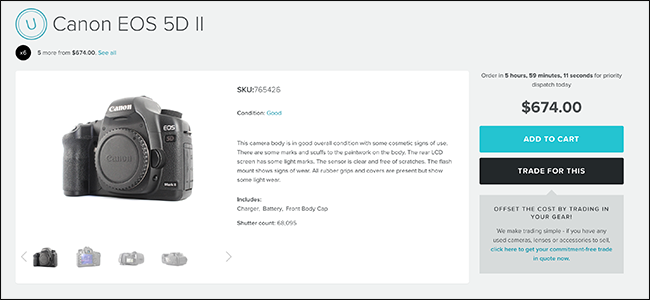
One decision that a lot of improving photographers face when it’s time to buy or upgrade their DSLR or mirrorless camera is whether they should buy a new crop sensor camera or an older, second-hand full frame camera. There are arguments to both sides so let’s dig in.
If you’re reading this article, you’re probably already familiar with the differences between full frame and crop sensor cameras. If you’re not, you should check out our full article on the subject, but, in brief, there are two main formats of DSLR and mirrorless cameras: 35mm or full frame and crop sensor or APS-C. Full frame cameras are based off the 35mm film standard while APS-C cameras use a sensor that’s about two-thirds the size. Professional cameras tend to use full frame sensors while consumer and entry-level cameras use crop sensors.
RELATED: What’s the Difference Between a Full Frame and Crop Sensor Camera?
Brand new full-frame cameras, like the Canon 5D Mark IV, cost a few thousand dollars. Even the Canon 6D Mark II starts at $1,600 on Amazon, although its list price is $2,000. Crop sensor models are a lot cheaper. The Canon Rebel T7i is $749 while our sister site’s pick for the best beginner DSLR, the Nikon D3400, is just $400—with an 18-55mm lens.
The thing is, you can buy second-hand full frame cameras for crop sensor money. You can get a good Canon 5D Mark II, one of the most successful professional cameras ever made, for around $600. A Canon 5D Mark III, the camera I use, can be had for less than a grand if it’s a bit beat up or about $1,300 if it’s in good condition. This means that, especially for improving photographers, there’s a choice to be made.
Consumer and Professional Cameras
As I mentioned above, full frame sensors get used in professional cameras while crop sensors get used in consumer cameras. The differences between the two are worth highlighting.
- Build quality: Professional cameras are designed to take a beating. They’re made out of aluminum alloys, often have weather sealing, and generally work anywhere. Consumer cameras are meant for vacations and family photos. They’re made from plastic, and a proper rainstorm might not be good for them.
- Better controls: Consumer cameras have lots of automatic modes, so you don’t really have to think about taking pictures. Professional cameras give you a lot more manual controls. Expect to see things like dedicated shutter speed and aperture dials, custom presets, and a more ergonomic layout.
- Multiple card slots: Multiple storage card slots let you shoot to two cards at once, so all your photos are backed up. Consumer cameras only have one.
- Different lens mounts: Consumer and professional cameras have different lens mounts. In general, full frame lenses will work on crop sensor cameras while the reverse is not true. If you have a lot of DX or EF-S lenses, this might be a dealbreaker.
- Better autofocus: Professional bodies—or at least recent ones—tend to have better autofocus with more points than consumer bodies.
And we haven’t even talked about image quality yet!
Although, that’s where things get a bit trickier and really, it depends on what two cameras you’re comparing. For example, a 5D III has a 22.3 megapixel full frame sensor while the T7i has a 24.2 megapixel crop sensor. They both have the same ISO range of 100-25,600. The 5D III, despite being older, definitely has the superior sensor. On the other hand, the 5D II has a 21.1 megapixel sensor and an ISO range of 100-6400. In good light, it is better than a T7i but in low light things are a lot less cut and dried.

Post a Comment Blogger Facebook
We welcome comments that add value to the discussion. We attempt to block comments that use offensive language or appear to be spam, and our editors frequently review the comments to ensure they are appropriate. As the comments are written and submitted by visitors of The Sheen Blog, they in no way represent the opinion of The Sheen Blog. Let's work together to keep the conversation civil.